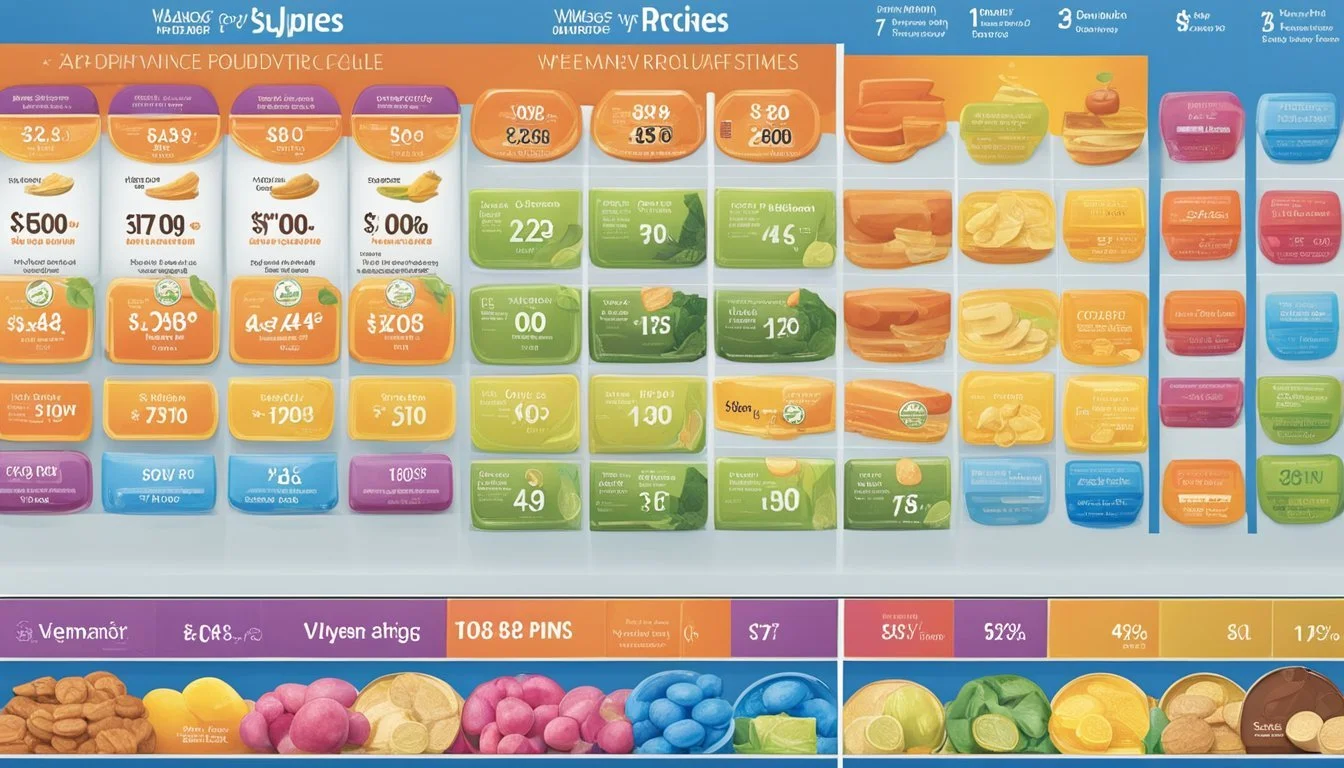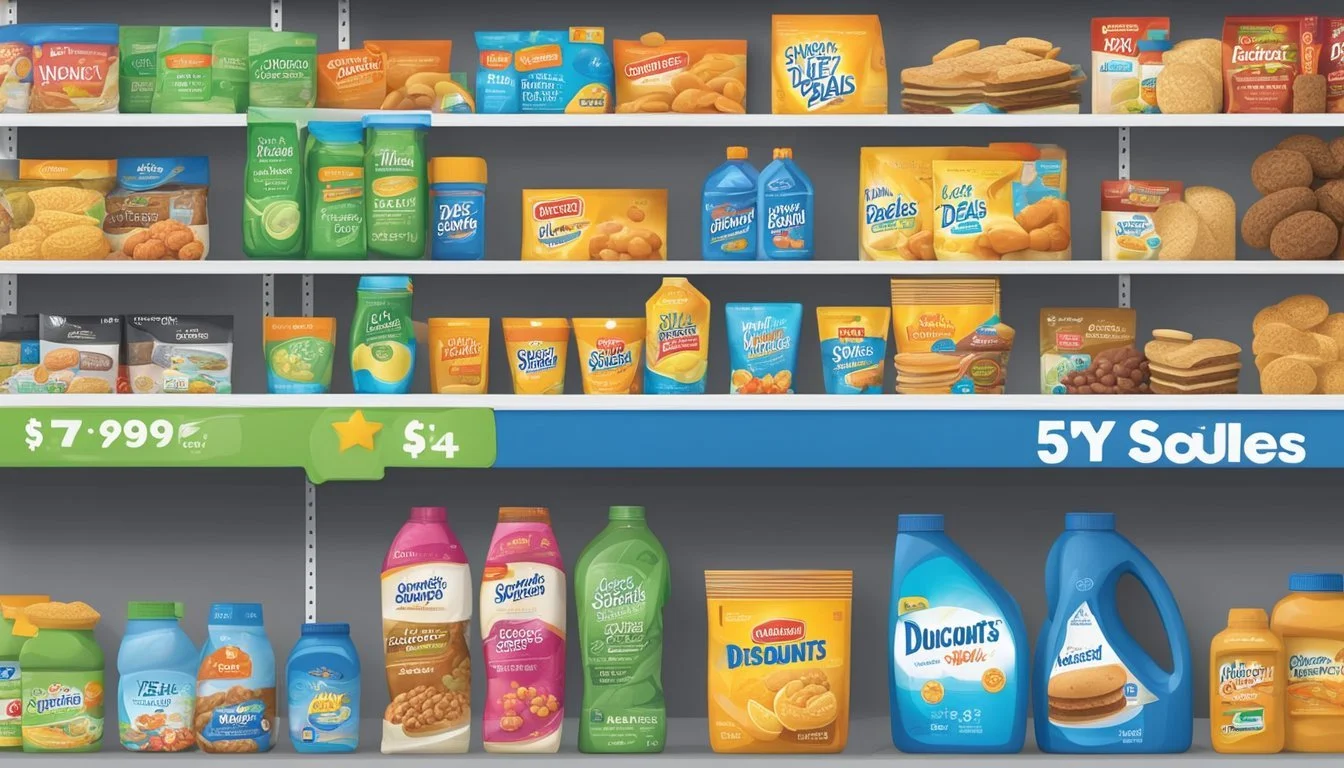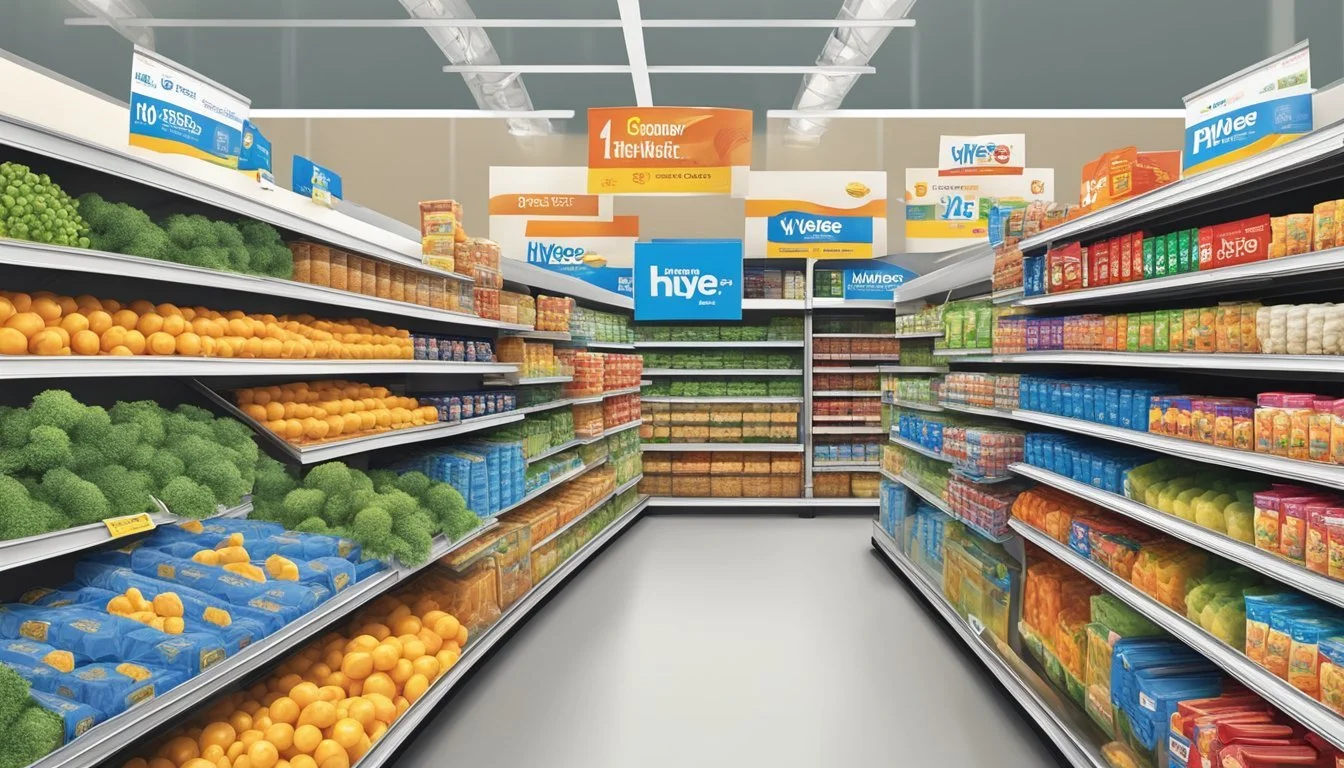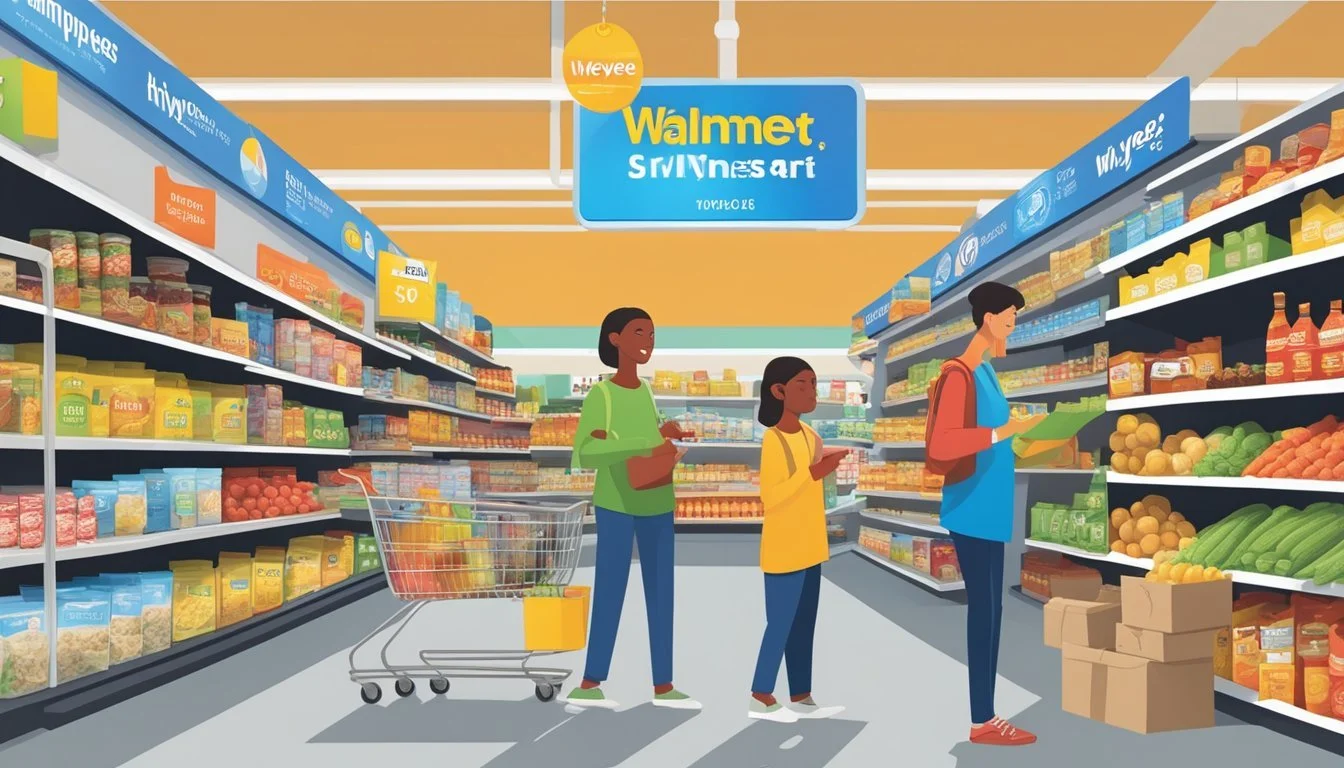Is Walmart Cheaper Than Hy-Vee?
Unveiling Grocery Pricing Facts
Part of Our Grocery Store Guide with Details on Walmart Prices and Hy-Vee Prices
When comparing the price points between Walmart and Hy-Vee, it's essential to consider their respective positions within the grocery market. Walmart is known for leveraging its massive distribution network and scale to keep prices low, often making it one of the most competitive options in terms of cost. On the other hand, Hy-Vee is a regional supermarket chain that focuses on providing a range of services and product selections, which may affect their pricing structure.
Shoppers typically find that Walmart's prices are about 20 percent lower than the average for grocery stores within the same area, including Hy-Vee. However, Hy-Vee frequently offers sales and promotions that can reduce the price difference on specific items occasionally. These contrasting strategies highlight the importance of considering individual shopping habits and preferences when determining which store offers the better deal for a shopper's specific needs.
Comparing Base Prices
When evaluating the base prices between Walmart and Hy-Vee for grocery items, consumers will notice a difference. Walmart is generally recognized for its commitment to keeping prices low. A cross-comparison of their prices with those of Hy-Vee indicates that Walmart often has more competitive pricing.
For instance, staple produce and meat items frequently have a price gap. Taking tomatoes as an example, Hy-Vee may offer them at a sale price of $0.99 per pound, in contrast to higher regular prices seen elsewhere.
Prices at Walmart tend to be lower:
Milk (1 gallon): Walmart's price is often less than Hy-Vee's offering.
Bread (loaf): Consumers might find the prices at Walmart to be more wallet-friendly.
Here's a snapshot of price differences for common items:
Item Walmart Price Hy-Vee Price Tomato (per lb) $0.89 $0.99 Milk (1 gallon) $2.89 $3.29 Bread (loaf) $1.99 $2.49
Walmart's strategic pricing sets a benchmark in the grocery sector, and competitors might aim to provide similar or slightly higher prices but potentially with added quality or service enhancements. Consumers are encouraged to consider both price and quality when making their purchases, and differences in pricing strategies can influence where savvy shoppers choose to spend their money. Pricing for produce and meat, in particular, is critical, as these are high-turnover items that affect a household's weekly budget.
Analyzing Product Quality
When comparing Walmart and Hy-Vee, product quality is a crucial factor for consumers. Walmart has positioned itself as a dominant retail giant, offering a diverse range of products including generic staples at competitive prices. Its focus is often on affordability, which can impact the overall quality of some product categories.
In terms of produce and meat, Hy-Vee tends to emphasize the quality of their offerings. Shoppers at Hy-Vee expect high-quality produce, with an array of organic and locally-sourced options, as well as meat that is often advertised as premium or specialty cuts.
The table below summarizes the differences in product offerings:
Criteria Walmart Hy-Vee Produce Wide selection, varied quality Focus on high-quality, organic options Meat Standard variety, economical pricing Premium selections, specialty items Generic Staples Extensive range, budget-friendly prices Quality options, may carry higher price tags
Hy-Vee is recognized for its commitment to sustainable food practices and has initiatives in place that focus on the wellbeing of the environment and local economies. Walmart, while offering a broad selection, may not always match Hy-Vee in specialty areas but compensates with a generally more affordable product range.
Consumers dedicated to high-quality produce and meat might lean towards Hy-Vee, appreciating their attention to detail and range. Budget-conscious shoppers who prioritize cost savings on staple items might find Walmart's selection sufficient for their needs. Both stores serve their respective customer bases with distinct approaches to product quality, catering to different priorities and preferences.
Brand Comparisons
When comparing Walmart and Hy-Vee, it's important to consider their respective approaches to brand offerings, including both store brands and national brands.
Store Brands vs National Brands
Walmart's store brand, known as "Great Value," provides a wide range of products from pantry staples to household goods. These items are typically priced lower than national brands while aiming to maintain a comparable quality. Hy-Vee also offers its own store brand, which includes a variety of products across different categories.
In general, consumers can expect to find store brands at both Walmart and Hy-Vee to be more cost-effective compared to national brands, as store brands do not carry the same marketing and advertising expenditures that national brands do. For commodities like milk and bread, price differences can be noticeable. For example, based on the search snippets, milk at Ralphs (which could serve as a proxy for comparing generic products) costs $2.49, while Hy-Vee's equivalent is $2.79.
While comparisons indicate that Walmart’s prices are often lower than Hy-Vee’s, the difference may not be uniform across all product types. Customers should also consider store brand quality, which both retailers work to ensure is high to foster customer loyalty. Additionally, both stores carry national brands, which allow for price comparisons between the two retailers directly.
It should be noted that shopping experience and other factors such as customer service and community involvement, as suggested by store policies and the consumer perception of Hy-Vee, may also influence a customer's decision beyond pricing alone.
Discounts and Deals
When assessing the affordability of Walmart versus Hy-Vee, one must consider the various discounts and deals each retailer offers. These can significantly impact the overall cost of groceries. Shoppers can take advantage of weekly sales, loyalty program benefits, and coupons to optimize their spending.
Weekly Sales and Special Offers
Both Walmart and Hy-Vee feature weekly sales that offer substantial discounts on a range of products. Hy-Vee is known for its "Hy-Vee deals" which are special offers that can include "Fuel Saver + Perks" on select items, potentially leading to additional savings on gas. Walmart, on the other hand, may implement loss leader pricing on key items to attract customers, especially around holidays like Valentine's Day, where specific goods may be discounted to drive traffic.
Loyalty Programs
Loyalty programs provide unique value to regular shoppers. Hy-Vee's "Fuel Saver + Perks" reward card allows customers to earn discounts on fuel and receive exclusive deals. Walmart does not have a traditional loyalty program but Walmart Plus membership offers perks such as free shipping and discounts on fuel at Walmart gas stations, which can lead to cumulative savings.
Coupons and Promo Codes
Coupons and promotional codes are a traditional way for shoppers to save. Hy-Vee accepts manufacturer's coupons and also offers its own in-store coupons, which can be found in weekly ads or digital form. Shoppers can use Walmart’s app and website to access digital coupons and apply them to online or in-store purchases, resulting in direct discounts at checkout. During promotional periods, both retailers may offer bonus discounts or special codes, adding value to routine shopping experiences.
Product Range and Availability
Walmart and Hy-Vee both offer a wide array of products, ranging from dry goods to fresh produce. Walmart, with its substantial global reach, generally provides a more extensive product range, catering to a diverse customer base. Their inventory includes a large selection of produce, meats, and pantry staples. Walmart also carries a variety of organic produce, though the selection may vary by location.
Hy-Vee, relatively smaller in scale compared to Walmart, positions itself as a supermarket chain that prioritizes quality and customer service. It offers an assortment of products, which typically includes a solid selection of produce, meat, and organic options. Hy-Vee stores are known for their emphasis on fresh, regional, and some specialty items which may not be as readily available at Walmart.
In assessing both stores, one can see a clear distinction:
Walmart
Extensive product range.
Larger variety of non-grocery items.
Greater emphasis on affordability.
Hy-Vee
Focus on quality and customer service.
Strong regional and specialty product lines.
Notable for fresh and organic produce options.
The product availability in each store might be influenced by regional demands and store size. While Walmart often excels in variety and price, Hy-Vee's strength lies in its specialized selections and commitment to quality, especially in the meat and organic produce categories.
Store Services
When comparing Walmart and Hy-Vee, both retailers offer a range of store services designed to enhance customer convenience, including robust online shopping and delivery options, as well as distinct in-store experiences.
Online Shopping and Delivery
Walmart provides comprehensive online shopping services with a variety of grocery delivery options. Customers are able to shop for groceries online through Walmart’s website or mobile app. They can then choose home delivery, which includes same-day delivery in many locations. Walmart also offers curbside pickup, where customers can have their online orders loaded directly into their vehicles at a designated pickup area.
Hy-Vee, similarly, extends its grocery delivery services to customers via its online platform. Shoppers can browse selections online and have their purchases delivered to them directly. Hy-Vee tends to emphasize their Aisles Online service, and they provide express options for quicker delivery. Additionally, the retailer offers a pickup service where groceries can be collected in-store.
In-Store Experience
At Walmart stores, customers can expect a consistent and standardized shopping experience. The layout is designed for convenience with clear signage and multiple self-checkout stations to expedite the payment process. Moreover, Walmart frequently integrates additional services like pharmacies, vision centers, and banking services to serve as a holistic shopping destination.
Hy-Vee prides itself on providing a personalized in-store experience. Their stores often feature specialty departments such as bakeries, delis, and sit-down restaurant areas. Hy-Vee also offers dietitian services and cooking demonstrations to engage customers. Furthermore, Hy-Vee’s customer service includes assisting with grocery selection, offering meal suggestions, and walking customers through their specialty departments.
Customer Perceptions and Research
In the retail landscape, customer perceptions play a pivotal role in shaping shopping habits and brand allegiance. A comparison between Walmart and Hy-Vee in terms of pricing illuminates varied consumer attitudes. Research often analyzes these perceptions through customer surveys, ratings, and academic studies.
Customer Surveys: Surveys have indicated that Walmart's pricing strategy is highly attractive to customers seeking budget-friendly options. The company's effort to offer lower prices typically results in Walmart's favor when put head-to-head with Hy-Vee. In a surveyed group, Walmart's prices were about 20 percent lower than the average of other retail stores, including Hy-Vee.
Quality Perception: Despite low prices, Walmart has encountered challenges with customer loyalty linked to perceived quality and customer experience. However, researchers observe that Walmart's initiatives to address these issues could lead to a shift in consumer perception.
Quality Ratings: Walmart's stride towards enhancing quality and customer service is reflected in its ratings over time.
Consumerpedia Podcast: Discussions on platforms like Consumerpedia often bring to light the trade-offs customers perceive between price and quality.
Researchers' Insights: Academics, analyzing Walmart's approach through the lens of behavioral economics, suggest that pricing heavily influences customer loyalty. Further research might explore whether Hy-Vee's customer experience affords it a compensatory edge over Walmart's lower prices.
In summary, research and surveys illuminate Walmart's competitive pricing advantage, while Hy-Vee's strengths may lie in different domains. Customers frequently base their choice on a balance of cost, quality, and overall shopping experience.
Cost-Saving Strategies
Shoppers aiming to reduce their grocery bills can employ several cost-saving strategies at Walmart and Hy-Vee. Walmart, known for its low prices, offers strategies that can help a family save money on their grocery shopping. Hy-Vee consumers can also utilize discounts and loyalty programs for savings.
At Walmart, one might find Everyday Low Prices and Rollbacks which are specific price reductions on various items. Families can benefit from these low prices without the need for additional programs. Walmart’s Savings Catcher app automatically compares prices with competitors and provides a rebate if a lower price is found elsewhere, ensuring shoppers pay the lowest price available.
In contrast, Hy-Vee shoppers can take advantage of the store's Fuel Saver + Perks® rewards card, which offers discounts not only on groceries but also on fuel, creating a dual saving effect. Making planned grocery lists and looking out for sales are practical strategies that Hy-Vee customers can employ to further keep spending in check.
Walmart Advantage Hy-Vee Advantage Everyday Low Prices Fuel Saver + Perks® Price Rollbacks Weekly Deals Savings Catcher app Personalized Offers
Shoppers should keep an eye on weekly ads and clearance items for both stores to snatch up deals as they arrive. Implementing these strategies will help consumers make the most of their grocery budgets.
Comparisons With Other Retailers
When considering Walmart in comparison to other retailers, price competitiveness is often at the forefront. This section examines how Walmart stands up against discounters like Aldi, Hy-Vee's positioning against regional supermarkets, and the role of online shopping platforms such as Amazon.
Walmart vs Aldi and Other Discounters
Walmart is established as a retail giant offering a vast array of products at competitive prices. It is known for being approximately 20% cheaper on average than many other stores. Aldi, well-regarded for its discount pricing structure, often runs neck and neck with Walmart in terms of affordability. Shoppers frequent Aldi for its deep discounts, especially on its private-label brands.
Aldi and Discounters:
Often offer lower prices on specific items, especially under their private labels.
Limited selection compared to Walmart's range.
Hy-Vee vs Regional Supermarkets
Hy-Vee prides itself on quality and customer service, which may reflect its pricing strategy. Compared to regional supermarkets, Hy-Vee focuses on tailored customer experiences and community involvement. However, regional competitors occasionally offer sales that can undercut Hy-Vee's regular prices.
Regional Supermarkets:
May offer competitive pricing during sales.
Smaller chains can sometimes provide specialized or local offerings.
Online Shopping Alternatives
The rise of online shopping platforms like Amazon has shifted the landscape of grocery pricing. Amazon Prime members enjoy additional discounts and deals not only on Amazon's platform but also at subsidiaries like Whole Foods. While Walmart and Hy-Vee have robust online options, warehouse clubs and other online alternatives like Target also compete in this digital marketplace.
Amazon Prime Discounts and Deals:
Exclusive for Prime members, often making online prices more attractive.
Whole Foods benefits from Amazon Prime member deals on groceries.
Warehouse Clubs and Target:
Offer competitive prices, sometimes lower than traditional stores for bulk purchases.
Target provides additional savings through its loyalty programs.
Additional Considerations
When comparing Walmart and Hy-Vee prices, it is crucial to consider how pricing may differ based on location and how the quantity and size of products can impact the unit price. These factors contribute to the overall cost-effectiveness of shopping at either store.
Geographical Pricing Variations
Prices at Walmart and Hy-Vee can vary significantly depending on the region. This is due to local economic conditions, varying operational costs, and competing retailers. For example, a Hy-Vee located in the Midwest might offer different pricing than a Walmart in the same area because of local supply chain efficiencies or competitive pressures.
Examples:
In urban areas, both stores might have higher prices due to increased overhead costs.
Regional promotions may lead to temporary price cuts at one retailer but not at the other.
Product Sizing and Unit Pricing
Shoppers should be vigilant about product sizing and unit pricing. This means comparing the price per unit (e.g., price per pound) rather than just the sticker price. Sometimes larger or bulk items offer more value, even if the upfront cost is higher.
Considerations:
Scales: Both Walmart and Hy-Vee typically have scales available in produce sections to help customers determine the price per pound.
Undersized items: Some products may appear cheaper but are actually undersized, resulting in a higher unit cost.
Unit pricing: Always check the unit price, which is often displayed on price tags in stores, to determine which store offers the better deal for the size of the product.
Product Walmart Price Per Pound Hy-Vee Price Per Pound Bananas $0.56 $0.59 Ground Beef $3.78 $3.99 Chicken Breasts $1.99 $2.29
Customers should use this information to inform their purchasing decisions, ensuring they get the most value for their money.
Hy-Vee and Walmart Market Presence
In the competitive landscape of American grocery chains, both Hy-Vee and Walmart have cultivated their own market presence with distinctive historical backgrounds and store expansions. They each cater to a large customer base, offering value and striving to build a loyal following.
Historical Development
Hy-Vee was founded in 1930, in Beaconsfield, Iowa by Charles Hyde and David Vredenburg. The company's name is a contraction of its founders' last names. Hy-Vee has built a brand centered around customer service and a wide range of products, including grocery items, which has helped it to cultivate a loyal following.
Walmart, on the other hand, started as a single discount store in Rogers, Arkansas in 1962. Founded by Sam Walton, it has now grown into one of the world's largest grocery chains and general retailers. Known for its significant value and cost saving, Walmart has expanded globally, impacting not just the American market, but international retailing as well.
Store Locations and Growth
Hy-Vee currently operates over 300 stores primarily in the Midwest. It has experienced steady growth over the years, maintaining a strong presence in the states it serves. The chain actively looks for new opportunities to expand its market reach by opening new locations.
Year Number of Stores 1995 100+ 2020 275+ 2024 300+
Walmart has a much broader reach, with a presence in all 50 states and numerous international locations. Its growth has been exponential; it is now known as America's biggest grocery chain, having thousands of stores worldwide. Their success is partially attributed to competitive pricing strategies and an extensive variety of products.
Year Number of Stores 1968 24 1988 1,198 2024 11,000+
Both retailers continue to expand their geographic footprint, each trying to maintain and increase its share of the grocery market. They adopt different strategies to stay relevant and keep up with the evolving retail landscape.
Nutritional and Healthy Food Options
When considering healthy food selections, both Walmart and Hy-Vee offer a range of choices catering to nutrition-conscious shoppers. They prioritize the availability of fresh vegetables and fruits, including organic produce, ensuring that customers have access to the essential components of a balanced diet.
Walmart has made strides in expanding its assortment of healthy foods. The retailer provides various organic options and places a strong emphasis on nutritional values. An example of their commitment to health can be seen in their produce aisle:
Freshly cooked asparagus: Rich in fiber, protein, and vitamins
Organic salads: A mix of leafy greens and veggies offering high nutritional density
Hy-Vee, on the other hand, also scores high marks for its health-oriented offerings. It boasts an array of wholesome choices that include:
Organic Produce: A wide selection assures quality and purity
HealthMarket: A dedicated section featuring natural and organic foods
Both stores emphasize the importance of healthful eating by providing these nutritional options:
Walmart Hy-Vee Organic Produce Available Available Fresh Veggies High Variety High Variety Health Labels Clear Nutritional Information Extensive Health Labels
In their commitment to health, both Walmart and Hy-Vee continuously seek to offer consumers nutrient-rich foods that support a well-rounded diet. Whether customers opt for Walmart's low-priced yet nutritious selections or Hy-Vee's dedicated HealthMarket offerings, they can find an array of products to meet their dietary needs.
Evaluation and Ratings Summary
When evaluating grocery stores, consumers often prioritize price. Walmart, known for its cost-leadership strategy, generally offers lower pricing compared to competitors. Hy-Vee, with a reputation for quality and customer service, might have different pricing standards that hinge on these aspects of consumer experience. This evaluation considers common items and uses ratings and feedback from area consumers to establish an understanding of value.
Ratings for Walmart indicate that its prices on a variety of goods are approximately 20 percent lower than the area's all-store average, portraying Walmart as a cheaper option. Hy-Vee's pricing, while potentially higher, is not necessarily 'expensive,' especially when the store's wider variety and service quality are factored into consumer ratings. These components might lend Hy-Vee “superior” overall ratings in departments other than pricing.
Store Common Item Price Rating Walmart Lower by ~20% High for Price Hy-Vee Varies High for Quality
Sources like the Consumerpedia podcast echo these sentiments by discussing how consumers evaluate stores not just on price but also on convenience, quality, and the shopping experience. In summary, ratings tables and price comparisons provide valuable insights, but they represent just a part of the criteria that constitute a consumer's choice. Hy-Vee and Walmart cater to different aspects of the consumer market, making a direct price comparison only one dimension of a multifaceted shopping decision process.
Consumer Insights and Feedback
When comparing Walmart and Hy-Vee, customer perceptions and expert assessments provide distinct perspectives related to pricing, quality, and service within the "grocery stores" category. Customers actively discuss their shopping experiences, while experts offer evaluations based on systematic comparisons.
Customer Surveys and Reviews
Customers often express their opinions on their shopping experiences at Walmart and Hy-Vee through surveys and online reviews. Walmart's reach in various areas provides it with a diverse swath of feedback. They are frequently praised for their amazing values, especially in the domain of staple items such as fruits and other groceries. On the other hand, Hy-Vee, with a smaller footprint, garners a variety of responses regarding their pricing and quality. Some specific stores may receive poor ratings due to customer dissatisfaction with either pricing or customer service.
Pricing: Often highlighted for competitive prices.
Service: Mixed reviews; some praise the convenience, while others note room for improvement.
Hy-Vee Customer Insights:
Quality: Generally receives positive mentions for quality offerings.
Service: Customer service is often appreciated, though the experience may vary by location.
Expert Analysis and Opinions
Experts analyze grocery chains by taking a more systematic approach, comparing wide-ranging criteria that include pricing strategies and overall value. According to expert assessments, Walmart's pricing is typically lower than Hy-Vee's, positioning Walmart as a cost-leader in the "grocery stores" category. Experts cite their extensive network and aggressive pricing strategies as key factors to their ability to offer lower prices.
Expert Views on Walmart:
Pricing: Recognized for being about 20% lower than the average of surveyed stores.
Options: A wide variety of options due to vast store network.
Expert Views on Hy-Vee:
Quality: Quality-focused services and products often highlighted.
Values: Considered by some to offer good value, but may not compete with Walmart on price alone.
The Impact of Retail Market Trends
The retail landscape is continuously shaped by evolving market trends, where e-commerce's expansion and shifts in consumer grocery shopping habits play significant roles. These elements directly influence how brands like Walmart and Hy-Vee position themselves competitively.
The Role of E-commerce
The advent of online shopping has compelled traditional grocery stores to innovate quickly, blending their in-store experience with the convenience of e-commerce. Walmart, for example, has made significant strides in enhancing its online presence, providing customers with options like curbside pickup and home delivery. This push toward digitalization not only aims to meet customers' expectations but also to compete with purely online entities such as Amazon.
On the other hand, supermarket chains including Hy-Vee have been leveraging e-commerce to increase their market share by offering similar services, ensuring that they retain their customer base and cater to a generation that favors digital channels for grocery shopping.
Current Trends in Grocery Shopping
Current market trends highlight a shift towards value and convenience. Consumers are increasingly looking for affordable options without compromising on quality. Key players in the market face the challenge of maintaining competitive pricing structures. For instance:
Walmart's pricing strategy has been recognized for its affordability, often averaging about 20% lower than many competitors' prices.
Hy-Vee, while not always the lowest in price, competes by offering a broad range of services and an emphasis on customer experience.
Moreover, supermarkets are noticing a trend where services are becoming a significant factor in attracting consumers. Wegmans and Market Basket emphasize customer service and a wide assortment of goods, balancing price with value-added services to enhance the shopping experience. The trend signifies a blend of price-consciousness with a demand for higher service levels, indicating that a supermarket's success lies not only in pricing but also in the overall value it provides to its customers.
Regional Comparison of Walmart and Hy-Vee
When comparing regional grocery pricing, Walmart typically undercuts Hy-Vee across various departments, including grocery, pharmacy, and bakery. Price trends suggest that Walmart's strategy is anchored in offering consumers lower average prices, although this may sometimes come at the expense of the perceived quality of produce and high-quality products.
In the Midwest, where Hy-Vee predominantly operates, consumers often weigh the balance between cost and quality. While Hy-Vee is known for a customer-centric approach and a wider selection of high-quality products, Walmart's expansive supply chain enables them to keep prices low, appealing to budget-conscious shoppers. Comparative shopping shows Walmart's pricing on items like dried goods and meats to be consistently lower, aligning with Walmart's reputation as a price leader.
Other regional competitors like Meijer and Jewel-Osco also factor into this analysis. Shoppers often find Meijer offering competitive prices similar to Walmart's, especially in the Great Lakes region. Jewel-Osco, while generally higher in price, is noted for its quality, directly competing with Hy-Vee's strengths in the market.
Across different regions, Food Lion, Sprouts, and Woodman’s partake in this competitive landscape. Each store has its own position, for instance, Sprouts emphasizes organic and natural foods often at a premium, whereas Food Lion is more aligned with Walmart's pricing. Woodman's, a player in the Upper Midwest, provides a large selection, occasionally outpricing both Walmart and Hy-Vee.
Notably, on the West Coast, Safeway and Albertsons engage in similar dynamics with Walmart. Both chains, like Hy-Vee, are recognized for quality but tend to have higher average prices compared to Walmart, with Cub often fitting between the two in terms of cost and quality.
In conclusion, while Walmart leads in low-cost groceries, regional counterparts like Hy-Vee maintain market share through quality and customer service, creating a diverse and competitive grocery landscape.
Conclusion
When evaluating cost-effectiveness between Walmart and Hy-Vee, data suggests that Walmart generally offers lower prices on a variety of goods. Significant savings, especially for customers with tight budgets, are found at Walmart. A shopper's potential savings could be around 20% less compared to average grocery store prices.
Hy-Vee, on the other hand, is often perceived as offering higher overall quality for its products and services. For consumers who prioritize premium shopping experiences and the availability of specialty products, Hy-Vee might provide added value despite higher prices. Regular sales and discounts at Hy-Vee can reduce the price disparity, making it a competitive option for budget-conscious buyers.
Price-conscious consumers have favored Walmart for essential items like dairy and produce, taking advantage of its consistently low price point. Here's a brief comparison on staple items:
Milk: Walmart is typically cheaper.
Eggs: Walmart tends to have lower regular prices.
One must also consider product variety, customer service, and shopping experience, which are qualitative aspects that influence a consumer's choice. Each store has crafted a distinct business model that caters to different customer needs.
In essence, for absolute value based on price alone, Walmart is the leading choice. However, for shoppers who weigh quality and service as equally important, Hy-Vee's pricing can be justifiable. Consumers are encouraged to assess their priorities when deciding between the two.












